Greyhounds achieve exceptional speed through their streamlined bodies, which reduce air resistance and improve airflow during a sprint. Their powerful hind leg muscles, filled with fast-twitch fibers, generate explosive force, while their skeletal structure keeps weight low yet durable. Precise limb mechanics and high stride frequency enhance acceleration and efficiency. Their neuromuscular coordination ensures smooth, rapid movements. By understanding these mechanics, you’ll uncover how greyhounds maximize their sprinting potential—keep exploring to learn more.
Key Takeaways
- Greyhounds have a sleek body shape and short fur to reduce air resistance and increase aerodynamic efficiency.
- Powerful hind leg muscles with fast-twitch fibers enable rapid acceleration and high top speeds.
- Precise neuromuscular coordination ensures synchronized limb movement and optimal timing for maximum speed.
- Their limb mechanics feature high stride frequency and elastic energy storage for efficient propulsion.
- Streamlined body contours and flexible tail enhance airflow and maneuverability during high-speed sprints.
The Unique Anatomy of Greyhounds
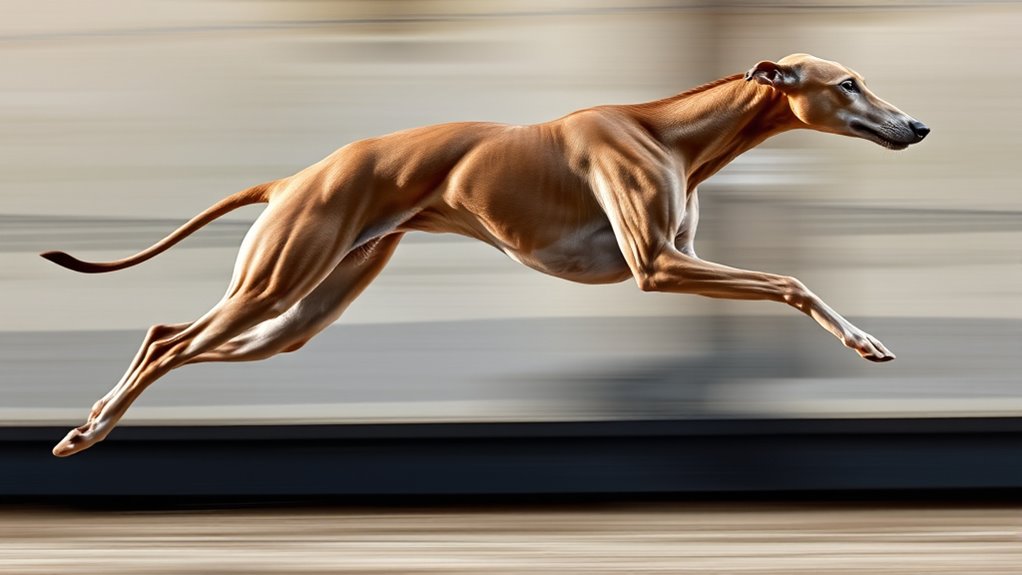
Greyhounds possess an extraordinary anatomy that makes them exceptional sprinters. Their sleek greyhound fur reduces air resistance, allowing them to move swiftly with minimal drag. The fur’s fine, short texture helps streamline their body, maximizing speed during a sprint. You’ll also notice their tail’s remarkable flexibility, which plays a critical role in balance and maneuverability. As they accelerate, their tail acts like a rudder, helping them change direction quickly and maintain stability at high speeds. Every aspect of their anatomy is optimized for rapid acceleration and top-end speed. From their smooth coat to the agile, flexible tail, each feature contributes to their incredible sprinting ability. This specialized structure makes greyhounds some of the fastest animals on the planet.
Muscle Structure and Power Generation
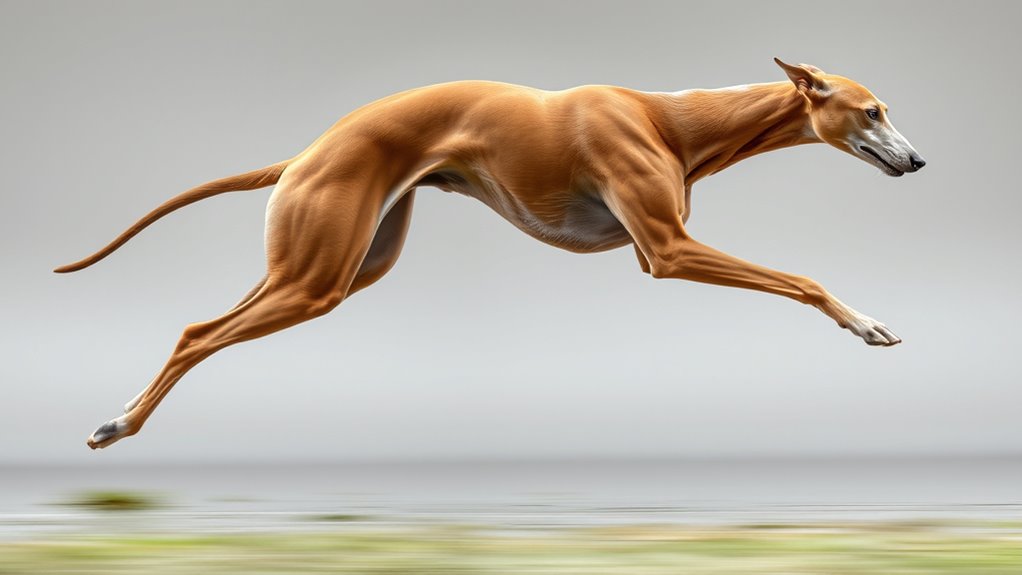
Have you ever wondered what gives greyhounds their explosive speed? It all comes down to their muscle structure and how they generate power. Greyhounds experience significant muscle hypertrophy, especially in their hind legs, which boosts their ability to produce force quickly. Their muscles are packed with fast-twitch fibers, enabling rapid contractions and high power output during a sprint. This muscle composition allows them to accelerate rapidly and reach incredible top speeds. Their muscles are not just larger; they’re optimized for quick, explosive movements, giving them a mechanical advantage over other breeds. The combination of hypertrophied muscle tissue and fiber type specialization is what makes greyhounds such exceptional sprinters, transforming their anatomy into a powerhouse for speed. Muscle hypertrophy is a key factor that enhances their overall sprinting capabilities, making their anatomy highly efficient for rapid acceleration.
The Role of the Skeletal System in Speed
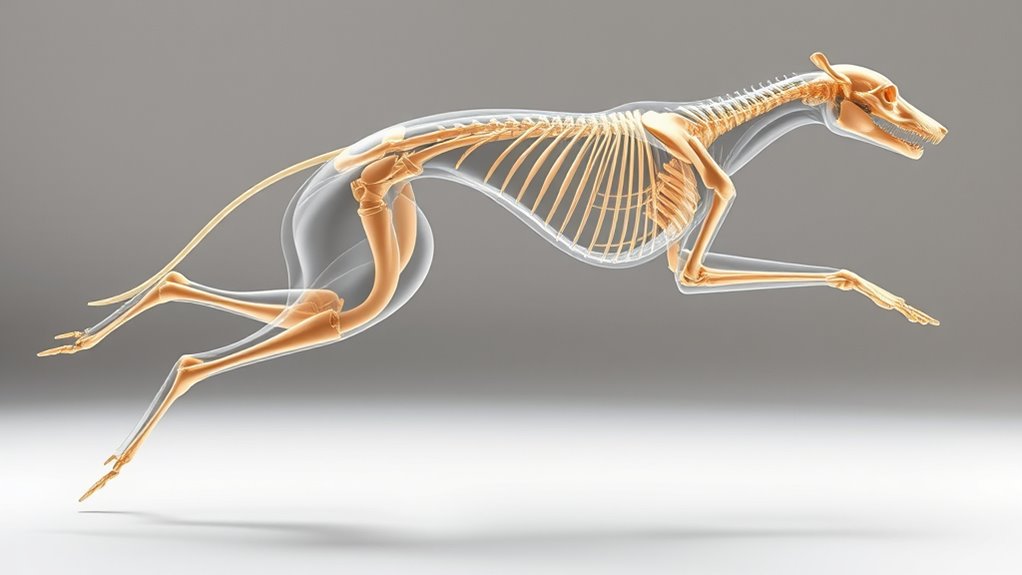
The skeletal system plays a vital role in enabling greyhounds to achieve their remarkable speed by providing a lightweight yet strong framework that supports rapid movement. Skeletal resilience ensures the bones can withstand the intense forces during sprinting, preventing fractures or injuries. High bone density contributes to this resilience, giving the skeleton durability without adding unnecessary weight. Your greyhound’s bones are optimized for speed, balancing strength and lightness to maximize agility and acceleration. The long limb bones act as efficient levers, translating muscular power into swift propulsion. Additionally, the flexible joints allow for a full range of motion, facilitating quick strides. The strength and durability of the skeletal system are essential for maintaining speed, endurance, and injury prevention during high-velocity pursuits.
Aerodynamics and Body Shape Optimization
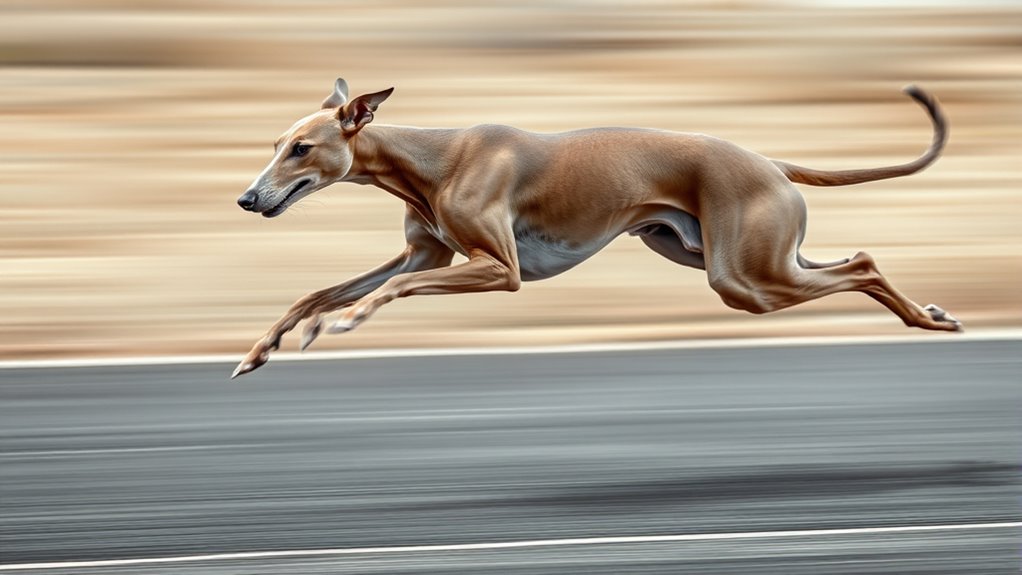
Aerodynamics and body shape optimization are essential for maximizing a greyhound’s speed, as a streamlined form reduces air resistance and allows for smoother, more efficient movement. By adopting an aerodynamic body shape, you enhance hydrodynamic efficiency, which minimizes drag during high-speed runs. The sleek silhouette of a greyhound is designed to cut through the air effortlessly, enabling faster acceleration and sustained velocity. Every curve and contour is optimized to channel airflow smoothly over the body, decreasing turbulence and resistance. This streamlined design not only improves speed but also conserves energy, allowing you to maintain top performance longer. Understanding body shape optimization can further refine a greyhound’s performance by tailoring physical features for maximum efficiency. Incorporating AI-driven design analysis can help identify subtle improvements in form that boost speed and reduce fatigue. Additionally, paying attention to muscle composition can optimize power output and endurance during races. Optimizing training techniques can further enhance a greyhound’s efficiency and overall sprinting capability. Focusing on aerodynamics and body shape ensures that a greyhound stays ahead in the race by maximizing efficiency with minimal drag. Implementing efficient movement techniques can also contribute significantly to overall speed and endurance during high-intensity sprints.
Limb Mechanics and Stride Dynamics
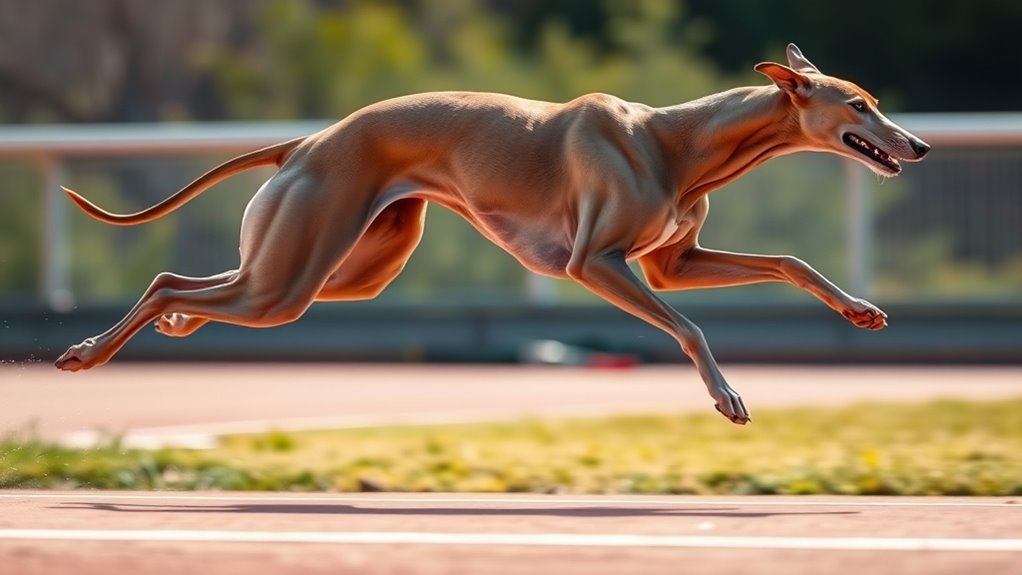
Limb mechanics and stride dynamics are essential for translating a greyhound’s streamlined body into rapid acceleration and sustained top speeds. You’ll notice that a high stride frequency allows for quick, powerful steps, maintaining momentum throughout a race. Limb elasticity plays a critical role, enabling your legs to store and release energy efficiently, reducing muscle fatigue. When your limbs extend and contract with ideal elasticity, each stride becomes more powerful and energy-efficient. Proper coordination between limb movement and stride pattern ensures smooth, continuous motion without wasted effort. This protective styling helps you achieve the rapid, rhythmic strides necessary for top-speed performance. Mastering limb mechanics and stride dynamics maximizes your ability to convert body shape into explosive speed and endurance on the track. Additionally, understanding how limb muscle coordination contributes to efficient movement can further enhance your sprinting capabilities. Recognizing the importance of body alignment can also improve overall stride efficiency and reduce injury risk. Incorporating precise joint flexibility can improve your range of motion, making your strides more effective and less prone to injury.
Energy Efficiency and Metabolic Adaptations
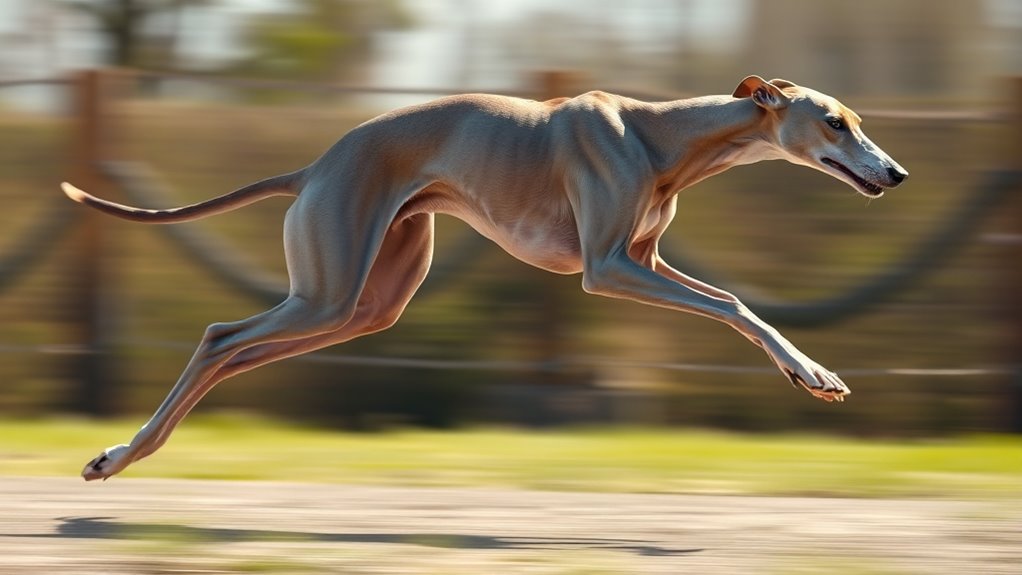
To sustain high speeds, greyhounds rely on highly efficient energy systems and metabolic adaptations that optimize fuel use and minimize fatigue. Their metabolic pathways, such as anaerobic glycolysis and aerobic respiration, are finely tuned to meet the demands of sprinting. During a race, they switch rapidly between these pathways to conserve energy and sustain maximum effort. This energy conservation allows them to maintain high velocities without exhausting their reserves quickly. Their muscles are adapted to efficiently utilize stored glycogen and fats, providing quick bursts of power while reducing metabolic waste. These adaptations help greyhounds perform at peak levels over short distances, ensuring they can execute rapid accelerations and maintain top speed with minimal energy depletion. Incorporating metabolic efficiency is crucial in understanding how greyhounds sustain their remarkable speed and endurance during sprints. Additionally, their muscle fiber composition enhances their capability for explosive movements and rapid recovery. Furthermore, their energy systems are optimized to support brief, intense exertion without significant decline in performance. Moreover, their oxygen delivery mechanisms are highly specialized to support rapid muscle activation and recovery during high-intensity efforts. Recent studies also highlight how their cardiovascular capacity plays a vital role in sustaining these intense efforts over the short duration of a race.
Neuromuscular Coordination During a Sprint
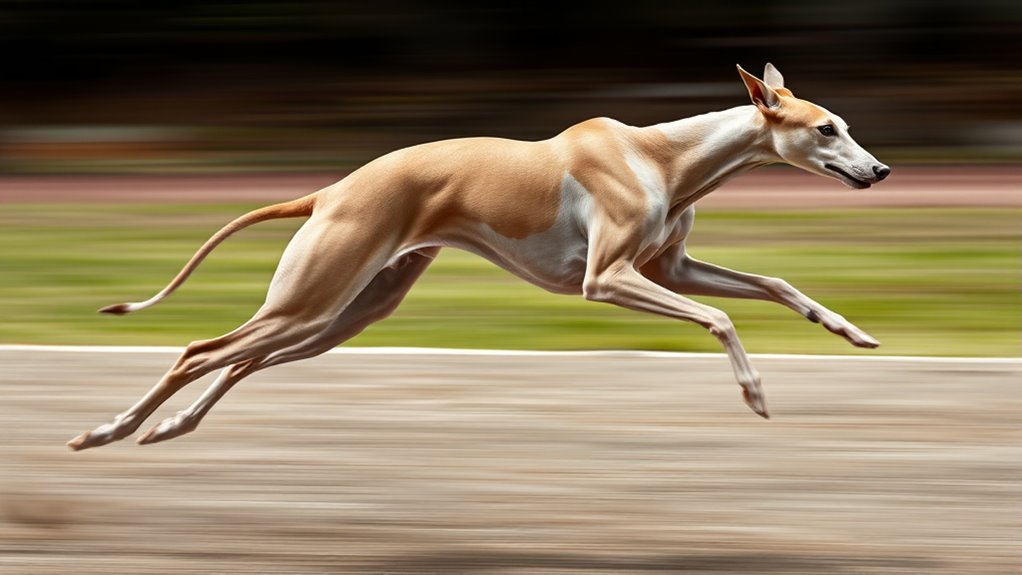
During a sprint, your muscles activate in precise patterns that maximize speed and efficiency. The timing of neural signals guarantees your limbs move smoothly and powerfully in coordination. This seamless coordination is what allows greyhounds to achieve such rapid acceleration and top speeds. Additionally, maintaining proper neuromuscular balance and control is essential for optimizing sprint performance.
Muscle Activation Patterns
Understanding muscle activation patterns is essential for grasping how greyhounds achieve their remarkable speed. During a sprint, your muscles activate in a precise sequence to maximize power and minimize wasted energy, directly impacting sprinting efficiency. When you start, your fast-twitch muscle fibers fire rapidly to generate quick, explosive movements. As you accelerate, your core stabilizes, and leg muscles coordinate to propel you forward smoothly. The activation of your hip, thigh, and calf muscles occurs almost simultaneously, guaranteeing optimal force transfer. Efficient muscle activation reduces unnecessary energy expenditure, allowing you to maintain top speed longer. This neuromuscular coordination ensures each stride is powerful and controlled, contributing to the greyhound’s impressive acceleration and sustained high-speed running. Proper muscle activation is vital to unlocking peak sprinting performance. Additionally, understanding muscle activation patterns helps in designing effective training regimes to improve overall sprinting ability, especially as recent studies highlight the role of neuromuscular coordination in athletic performance. A thorough knowledge of muscle activation timing can also aid in injury prevention by ensuring muscles work harmoniously during high-intensity efforts, and training specificity plays a crucial role in optimizing these activation patterns. mindfulness practices can further enhance connection to these activation patterns.
Neural Signal Timing
Neural signal timing plays a crucial role in ensuring your muscles work together seamlessly during a sprint. Precise timing allows your nervous system to send rapid, synchronized signals to your muscles, optimizing power and speed. When neural signal timing is efficient, your muscles activate at the right moments, generating maximum force with minimal delay. Synaptic efficiency at the neuromuscular junction enhances this process, enabling quick transmission of signals from nerves to muscles. This coordination reduces wasted energy and prevents misfires, ensuring smooth, rapid movements. As you sprint, your nervous system fine-tunes neural signal timing, allowing your muscles to respond instantaneously to commands. This tight control is essential for maintaining high velocity and achieving the explosive acceleration characteristic of a greyhound’s sprint. Additionally, neuroplasticity allows your nervous system to adapt and improve these processes through training and practice. Effective neural communication is fundamental for optimizing athletic performance and agility, and understanding the importance of neuromuscular coordination can help in designing better training protocols. Moreover, ongoing research suggests that training adaptations can further enhance neural signal timing and muscle responsiveness, leading to better sprinting mechanics.
Coordinated Limb Movement
Efficient neural signal timing sets the stage for coordinated limb movement, allowing your muscles to work together seamlessly during a sprint. This coordination is vital for maintaining optimal limb synchronization and stride coordination. When your nervous system sends signals precisely, your limbs move in harmony, maximizing speed and stability. The table below illustrates key elements:
| Limb Synchronization | Stride Coordination |
|---|---|
| Synchronized muscle firing | Smooth transition between steps |
| Precise timing of limb movement | Consistent stride length |
| Rapid response to sensory input | Balanced weight transfer |
| Minimized muscle lag | Enhanced propulsion |
Factors Influencing Sprint Performance
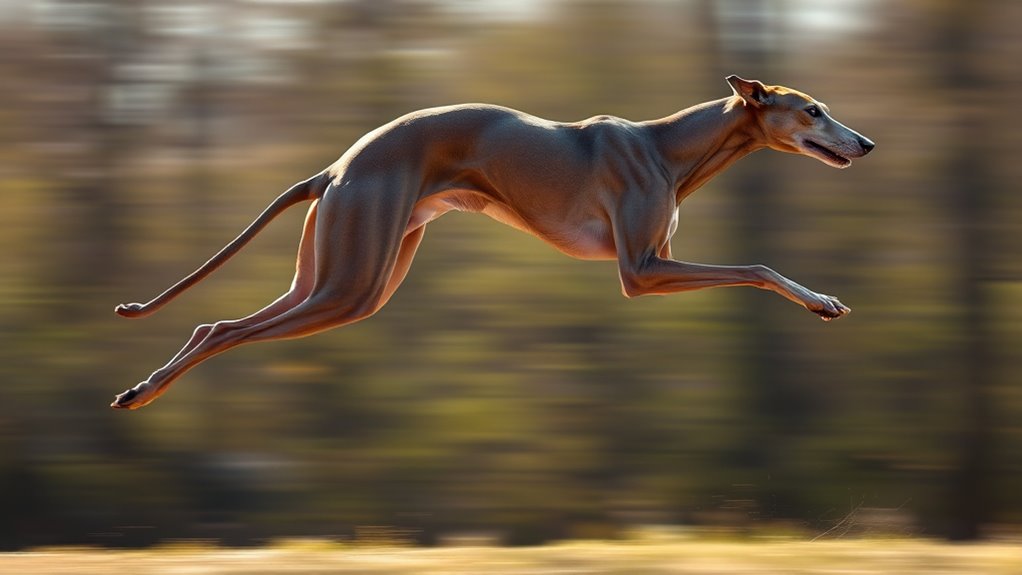
Your greyhound’s sprint performance depends on several key factors. Improving muscle strength and power allows for more explosive pushes, while optimizing stride length can maximize speed. Additionally, both aerobic and anaerobic capacities play crucial roles in sustaining quick, powerful runs.
Muscle Strength and Power
Muscle strength and power are critical factors that directly impact a greyhound’s sprinting ability. You can enhance these qualities through targeted muscle hypertrophy, which increases muscle size and force production. Power training, involving explosive movements and resistance exercises, helps develop the fast-twitch muscle fibers essential for rapid acceleration. Stronger muscles generate greater propulsive force, enabling you to reach top speeds quickly. Increased muscle strength also improves stability and reduces injury risk during high-intensity sprints. Consistent training focused on building muscle hypertrophy and incorporating power exercises boosts overall performance. Remember, the key lies in balancing strength development with explosive effort, ensuring your muscles can generate maximum force in minimal time. This combination ultimately enhances your sprinting mechanics and performance.
Stride Length Optimization
Building on muscle strength and power, optimizing stride length is key to maximizing sprinting performance. A longer stride can increase your overall pace, but only if it’s balanced with stride frequency. If your stride is too long, you risk sacrificing pace consistency, which can slow you down. Conversely, focusing solely on increasing stride frequency might lead to shorter, less powerful strides. The goal is to find the ideal stride length that allows you to maintain a steady pace without overextending or losing rhythm. Proper technique, body positioning, and muscle coordination help in achieving this balance. When you optimize stride length, you improve your ability to sustain high speeds efficiently, making every stride count toward your maximum sprinting potential.
Aerobic and Anaerobic Capacity
Both aerobic and anaerobic capacities play crucial roles in sprint performance, influencing how quickly and efficiently you can accelerate and maintain top speed. Enhanced muscle oxygenation allows your muscles to work efficiently during intense efforts, delaying fatigue. Your anaerobic system provides the rapid energy needed for explosive starts and short bursts, but it produces lactate, which can limit performance if accumulated beyond your lactate threshold. Training to improve your aerobic capacity helps clear lactate more effectively, delaying fatigue and enabling sustained high-speed runs. By balancing these systems, you can optimize your sprinting mechanics, ensuring quick muscle responses and prolonged speed. Ultimately, a well-developed aerobic and anaerobic capacity supports your ability to sprint faster and longer, keeping you competitive on the track.
Frequently Asked Questions
How Do Greyhounds’ Breathing Techniques Enhance Their Sprinting Ability?
Your breathing techniques play a vital role in boosting your sprinting ability. By maximizing respiratory efficiency, you guarantee your body gets enough oxygen intake during intense activity. This heightened oxygen supply helps sustain your energy levels and delay fatigue. Efficient breathing also allows you to recover faster between sprints, maintaining peak performance. Overall, your controlled and deep breaths optimize your stamina and speed, making you a more powerful and enduring sprinter.
What Is the Fastest Recorded Speed of a Greyhound During a Race?
You might wonder about the fastest recorded speed of a greyhound during a race. During peak acceleration, a greyhound can reach speeds of up to 45 miles per hour, showcasing impressive racing stamina and agility. This incredible acceleration allows them to maintain high speeds for short distances, making them one of the fastest land animals. Their ability to quickly reach top speed highlights their specialized physique and training for racing excellence.
How Do Environmental Conditions Affect a Greyhound’s Sprint Performance?
You might not realize it, but environmental conditions greatly impact a greyhound’s sprint. For example, a smooth track surface helps maintain maximum speed, while rough or uneven surfaces slow them down. Weather conditions like high heat or humidity can cause fatigue, reducing performance. Conversely, cool, dry weather and a well-maintained track surface enable your greyhound to reach top speeds, ensuring an exciting and competitive race.
What Training Methods Optimize a Greyhound’S Sprinting Efficiency?
To enhance a greyhound’s sprinting efficiency, you should focus on targeted training methods. Incorporate training drills that enhance speed, agility, and stamina. Combine these with muscle conditioning exercises to strengthen key muscle groups, improving power and reducing injury risk. Consistent, progressive training helps your greyhound develop ideal stride length and stride rate, ultimately maximizing performance. Regular assessment and adjustments ensure continuous improvement in their sprinting capabilities.
How Does Age Influence a Greyhound’S Sprinting Mechanics?
Imagine a greyhound’s body as a finely tuned machine, but as it ages, rust and wear set in. You’ll notice age-related joint degeneration and muscle mass decline, like sagging wires and weakened gears. These changes slow down the sprinter, reducing stride length and power. You see, age impacts mechanics by diminishing agility and strength, making it harder to maintain that lightning-fast burst, much like a once-sleek engine losing its spark.
Conclusion
As you watch a greyhound burst forward, imagine the sleek arrow slicing through air like an ancient messenger racing across time. Their anatomy, a perfect symphony of muscle, bone, and breath, transforms energy into raw speed. Like a legendary chariot driven by relentless purpose, each stride echoes the timeless pursuit of excellence. Embrace the wonder of their sprint—nature’s masterpiece in motion, forever reminding us of speed’s true art.










